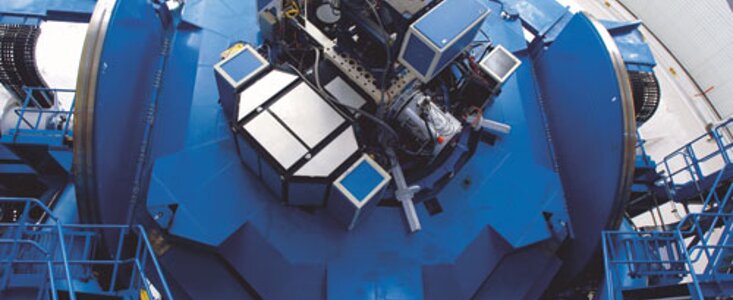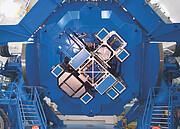Multi-Instrument Nights at Gemini North and South: a Powerful Approach to Observing
22 November 2005
The instrument clusters located at the Cassegrain foci of the Gemini telescopes are perhaps the most unique collections of astronomical instrumentation ever assembled on ground-based telescopes. Each cluster contains as many as four specialized instruments, each of which observes in a particular wavelength regime. When fully populated, both Gemini North and South can observe from the optical, through the near-infrared, and into the mid-infrared, covering a wavelength range from 0.4 to 25 microns.
The Gemini South complement of instruments contains the optical imager and multi-object spectrograph GMOS, the mid-infrared imager/spectrograph T-ReCS, the near-infrared spectrograph GNIRS, and the high resolution spectrograph Phoenix. In addition, the optical high-resolution spectrograph bHROS is located in the pier of the telescope and is fed by a fiber link from GMOS. At Gemini North, the optical imager and multi-object spectrograph GMOS, the mid-infrared imager/spectrograph MICHELLE, the near-infrared imager/spectrograph NIRI, and the "point-and-shoot" adaptive optics system ALTAIR are the constituents of the cluster. The new near-infrared integral field spectrograph (NIFS) will soon be available for use at Gemini North when it begins to share time with MICHELLE on the telescope.
The ports on the telescopes are not just a convenient place to store the instruments. Each of them is "alive" and ready to observe while on the telescope at any time during the night. This is one of the main reasons why Gemini has moved into an era of "multi-instrument" queue observing where we can observe with one or more (or even all) of the instruments each night. Many factors determine when we switch from one instrument to another. Matching the correct instrument with the current weather conditions is a driving factor. However, the phase of the Moon and the availability of high-priority targets also play a part in the determination.
At Gemini North we have scheduled progressively more multi-instrument nights during the last eight months, and we are starting to realize increased observing efficiency as a result. We find that with robust nightly queue planning, and the judicious choice of when to change instruments, multi-instrument observing is as efficient as using a single instrument all night. This is particularly true for nights when the weather conditions are unstable and rapidly changing, because we can match the conditions at that moment with the instrument that can best exploit what the sky is providing.
Another important point related to multi-instrument observing is that in the Gemini system there is no extra overhead encountered when switching between instruments. On the telescope itself a switch involves little more than swinging the tertiary mirror (located in the center of the instrument cluster) into the correct position so that the requested instrument is aligned with the beam of the telescope. This process takes about a minute and is performed while the telescope is slewing to the next target. Simultaneously, the observer in the control room brings up the appropriate instrument interface screens, loads the next observation sequence into the observatory control system, configures the instrument, and gets ready to take data. It is now extremely rare to see an instrument switch take longer than the median time of six minutes to switch between targets.
For more information on this topic, see the articles: "Observing Efficiency at Gemini Observatory" and "Gemini Queue Operations and Completion Rates" starting on page 54 of the December 2005 issue of GeminiFocus available in early December 2005



